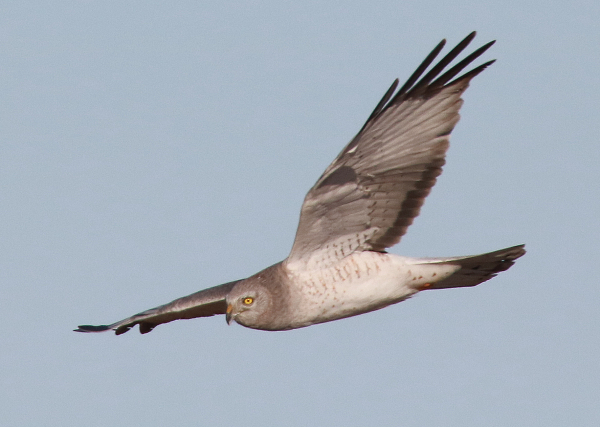
The key to good raptor photos is to show their eyes and the outline of their beak as clearly as possible, which is often more of a photo editing ingredient than something you can gauge while photographing a gliding male Northern Harrier.
|
The first 2 weeks of Northern Harrier migration through the area, all my sightings were of males, which is typical of spring migration, with the males flying north first. But Friday the females appeared and Saturday a few yearlings were also present. Both days were punctuated with excellent opportunities to photograph these specialized hawks during their low stealthy hunting flights. And with 3 to 6 harriers on the hunt before me with the low sunlight beaming from behind me both Friday and Saturday, how could I resist. Actually, I was thrilled to spend an hour-plus each of the evenings in the company of these adept fliers as they coursed low above cattail marshes intently scanning the vegetation and ground with specialized eyes and ears.
Friday’s Northern Harrier photo extravaganza was located just 3 miles south of home; Saturday, I traveled to McKenzie Slough, a favorite photo location 17 miles east of my home town of Bismarck. Friday was extremely windy and the photography had an edge to it, with harriers fighting the wind and flying almost predictable patterns into the north wind – the photo ops were fast-paced and exciting. Saturday the wind was light and the harriers could fly as they pleased, which was enjoyable to watch and to photograph as the birds provided an enhanced experience that I thoroughly enjoyed.
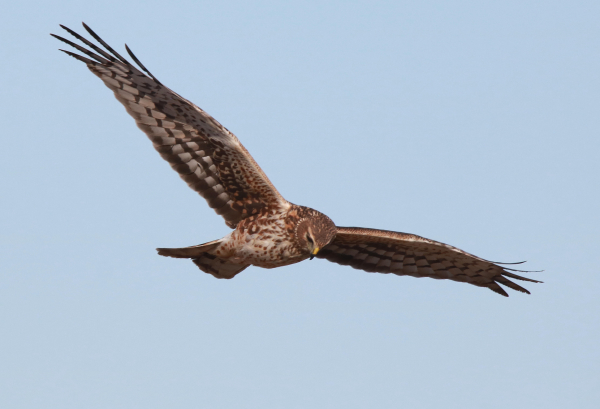
Northern Harriers are excellent photo subjects as far as raptors go, although they are relatively unique in that they engage in low-level flights, closer to our earth-bound elevation than other hawks. Their characteristic low flights are a result of utilizing their acute hearing in concert with their enhanced eyesight. When you get a good look at a harrier’s face, you can see it has a circular facial disc, specialized feathers that are somewhat similar to those forming the facial disc on an owl’s face. These feathers help to focus sound to their ears, that provides a binary predatory focus as a harrier uses its eyes and ears together. To best use their hearing though, they need to fly low to the ground or vegetation, which brings them closer to our level.
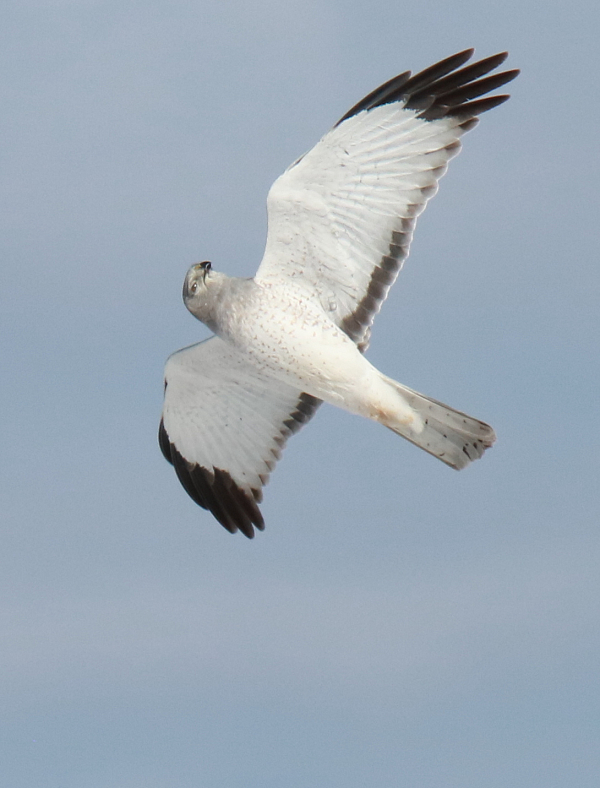
In the strong wind, a simple upturn propelled this male Northern Harrier quickly upward, showing its light-colored underside and quick reflexes in flight. This photo was taken using an aperture of f8 with a corresponding shutter speed of 1/2000 of a second, which provided a sharp, bright image.
|
As often happens, I used my vehicle as a mobile blind, positioning myself to take advantage of as many close harrier flights as possible. It was warm enough to keep the engine turned off most of the time, and I steadied my camera lens on the side of the open window frame; when photographing I held my breath to reduce any body-to-camera motion. Often I could keep my lens steadied against the window frame even when following the movement of the harriers in flight, although sometimes I had to get into the swing of things as birds hunted closer to my position.
To keep the moving birds in focus, I try to rely on my lens to stay locked in on moving birds, but I often re-focus when following a bird’s ambling flight, just as a precaution to ensure as sharp a focus as possible. To re-focus I merely touch the shutter button to make sure the bird is within focus as it moves up and down, closer and father away.
I usually take single frame photos rather than rapid bursts of photos, although I may take 2 or more photos in singular succession to try to get images with the wings up and then down. As always, the key is to try to anticipate the next move, and react in kind – a split-second in advance if possible. But I always photograph using the Al Servo setting, so when an optimum situation presents itself I can take a rapid burst of photos simply by holding down the shutter button. Depending on your camera model, it may be capable of taking from 3 photos per second to more than 10 per second, which provides an interesting series of photos to view and select from when you are photo editing.
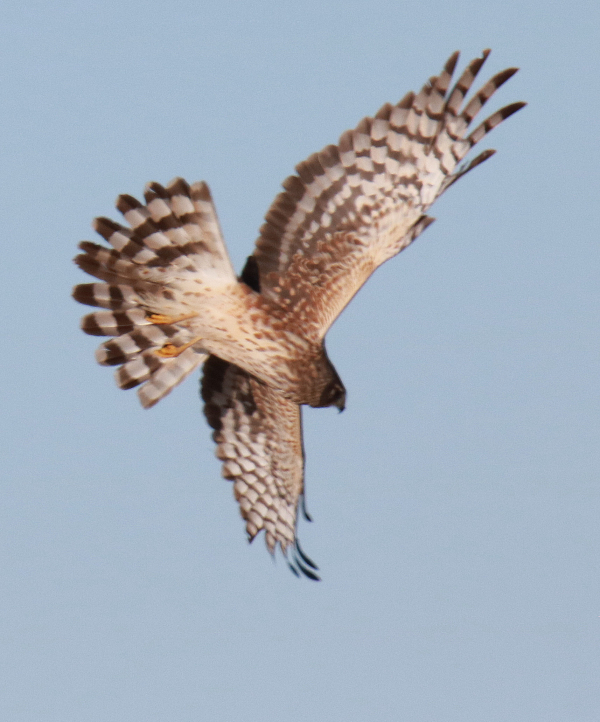
When this female Northern Harrier spun around in response to prey sighted below, the photographer needed to be alert, anticipate the hawk’s next move, or be lucky to document the quick change of action.
|
The best fun was when a Northern Harrier would turn in my direction, and I’d zero in on it as it approached, hoping for it to come within close range and maybe flare to the side or even upward into the wind. Certainly, harriers can often be seen tipping to one side and another, and of course there were moments when there were no harriers before me, but I always had to keep alert, in every direction, because as often happens, one would suddenly appear from behind and to the left, and I hated to miss any good photo opportunities. Then too, there were other birds to focus on – many species of ducks, Giant Canada Geese, and even 2 American Tree Sparrows lingering among the cattails.
With all that hunting going on, I only witnessed a couple dives into the cattail cover after potential prey – par for the hunt I expect. And the only prey I saw was not a rodent, it was a male Red-winged Blackbird clutched in the talons of a male Northern Harrier as it moved from the catch site to a feeding location close by. I found it interesting that I saw no blackbirds on territory across the cattail marsh, yet there was at least one semi-hidden down low.
Northern Harriers are relatively common across the continent, and they are the only member of the harrier family (genus Circus) to be seen in North America, there are 15 more harriers in the Old World (Eastern Hemisphere) that inhabit areas of Africa, Australia, Asia, or Europe.
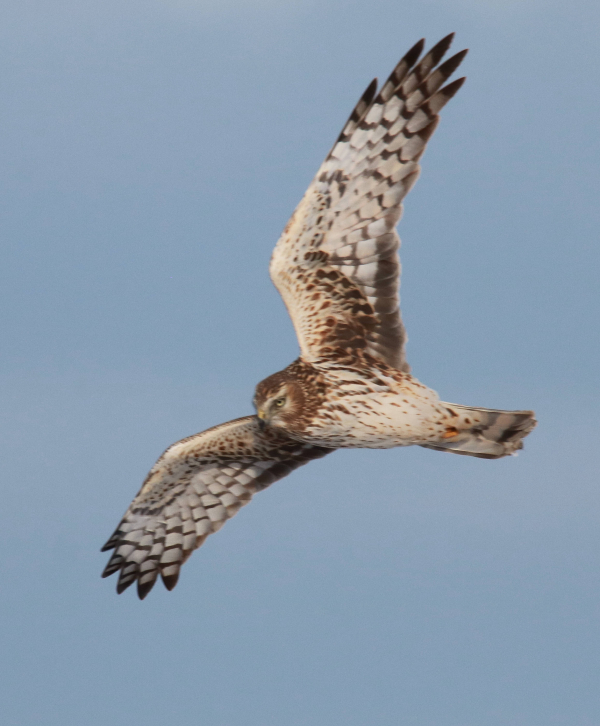
This photo shows a level of drama, but as noted in the first photo’s caption, the key to good raptor photos is to show their eyes and the outline of their beak as clearly as possible. How much does the “hidden” beak detract from the overall image?
|
But even within our singular species of Northern Harriers, there is a lot of variation in plumage that provides a variety of photo records, as well as insights into the composition of populations regarding males, females, and first-year harriers. Adult males and females are easy to distinguish, with the dorsal sides of males colored silver to gray and females brown. But it took time for me to learn about the plumage differences between females and young harriers. First-year harriers look brown from a distance in the field, but when you get a better look, they have a richer rufous-brown coloration and an light-orange underside.
Photographing individual birds can help us appreciate the colors and variations among individuals, and it helps us gain a better appreciation for given species. This can be especially true for birds of prey, but photography is an amazing aid for birders as we improve our birding abilities, interests, and activities. Spring migration is not only an exciting time for birding, it’s a period where we can rapidly improve as birders in a compressed period pf time – each year, often with the help of our photographs. Enjoy all your spring migration photo experiences, and Good Luck!
Article and photographs by Paul Konrad
Share your bird photos and birding experiences at editorstbw2@gmail.com